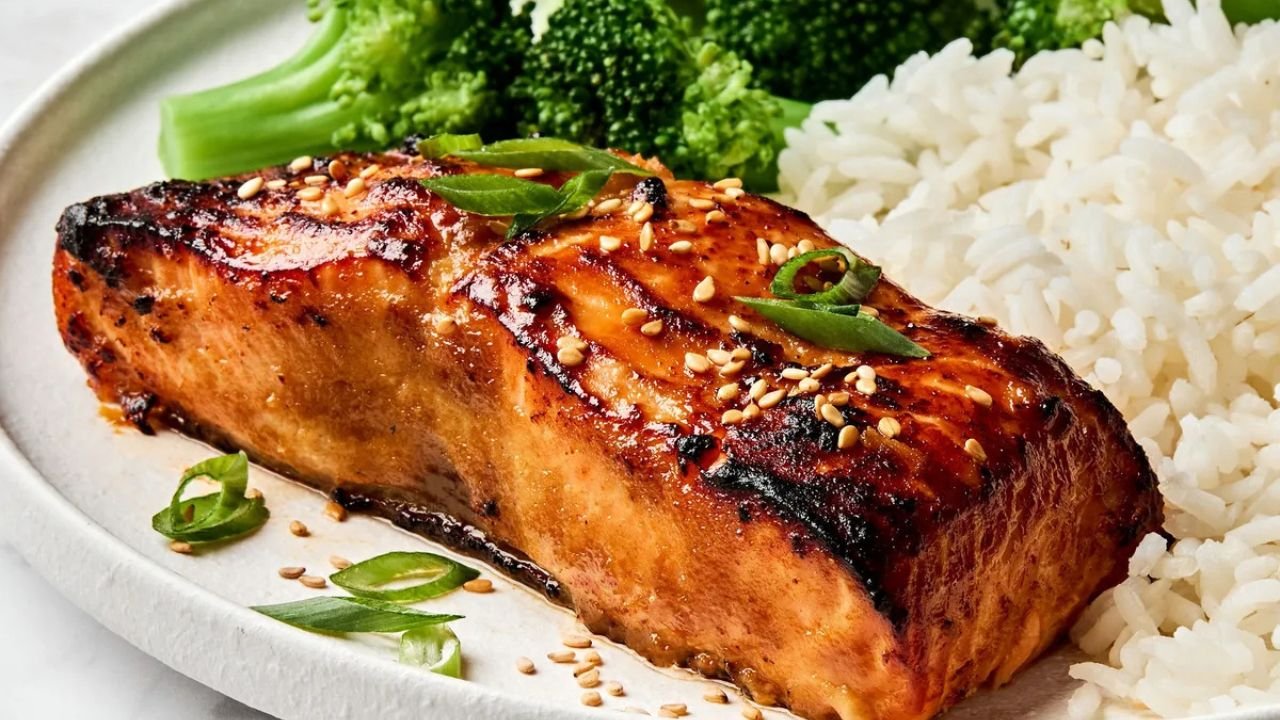Introduction
Salmon, with its rich flavor and tender texture, has become a staple in many cuisines around the world. Its versatility allows it to be prepared in countless ways, from simple grilling to complex sushi. Among the myriad of cooking styles, Miso-Glazed Salmon stands out as a perfect union of Japanese tradition and modern gastronomy.
This dish combines the umami depth of miso—a fermented soybean paste—with the succulent richness of salmon, creating a flavor profile that is both savory and slightly sweet, with a hint of smokiness if grilled or broiled. Its popularity has soared globally due to its health benefits, ease of preparation, and sophisticated taste.
In this comprehensive guide, we will delve into the origins of miso-glazed salmon, explore its ingredients, discuss various cooking methods, examine health benefits, provide pairing suggestions, and share tips for making the perfect dish every time.
1. The Origins and Cultural Significance
1.1 The Roots of Miso in Japanese Cuisine
Miso is a traditional Japanese fermented soybean paste that has been a cornerstone of Japanese cuisine for centuries. It dates back over a thousand years, with origins believed to have been influenced by Chinese fermented bean pastes.
Miso is made from soybeans, salt, and a fermenting agent called koji (a mold called Aspergillus oryzae). The fermentation process can range from weeks to years, resulting in various types of miso—white (shiro), red (aka), and mixed (awase)—each with distinct flavors and uses.
1.2 The Evolution of Miso-Glazed Fish Dishes
Japanese cuisine features many fish dishes with miso, especially in regions like Kyoto and Tokyo. The technique of glazing fish with miso before grilling or broiling is traditional, often used for saba (mackerel), black cod, and salmon.
The modern adaptation of miso-glazed salmon gained popularity in the West during the late 20th and early 21st centuries, influenced by Japanese culinary techniques and the global rise of Asian-inspired cuisine. Its balance of umami and sweetness makes it appealing to diverse palates.
1.3 The Global Appeal
Today, miso-glazed salmon is a staple in upscale restaurants, home kitchens, and meal delivery services worldwide. Its popularity is driven by its flavor complexity, health benefits, and ease of preparation, making it a favorite among both home cooks and professional chefs.
2. Ingredients and Their Significance
2.1 Salmon: The Star of the Dish
Varieties of Salmon:
- Atlantic Salmon (Salmo salar): Commonly farmed, mild flavor, tender flesh.
- Sockeye Salmon: Richer color and flavor, firmer flesh.
- King Salmon (Chinook): Very fatty, luxurious texture.
- Coho Salmon: Moderate flavor, good balance.
Choosing the Right Salmon:
- Freshness is critical—look for bright eyes, firm flesh, and a clean smell.
- Wild vs. farmed: Wild salmon tends to have a more complex flavor and firmer texture but can be more expensive.
- Fillet or steak: Both work well; fillets are easier to cook evenly.
2.2 Miso Paste: The Umami Foundation
Types of Miso:
- White Miso (Shiro): Milder, slightly sweet, fermented for a shorter period.
- Red Miso (Aka): Stronger, more pungent, fermented longer.
- Mixed Miso (Awase): A blend of white and red, balancing flavor.
For glaze, white or mixed miso is often preferred for a sweet and savory balance, but red miso can be used for a more intense flavor.
2.3 Sweeteners
- Mirin: A sweet Japanese rice wine that adds depth.
- Honey or Maple Syrup: Natural alternatives for sweetness.
- Brown Sugar: Common in traditional recipes.
2.4 Other Flavor Enhancers
- Soy Sauce or Tamari: Adds saltiness and umami.
- Sake: Mild alcoholic beverage that tenderizes and enhances flavor.
- Rice Vinegar: For acidity and brightness.
- Sesame Oil: Adds nutty aroma.
2.5 Aromatics and Garnishes
- Ginger and Garlic: For added depth.
- Green Onions or Chives: Fresh garnish.
- Sesame Seeds: Toasted for crunch and flavor.
- Lemon or Lime Wedges: For brightness.
3. Preparing Miso-Glazed Salmon
3.1 Basic Marination Technique
Step 1: Prepare the Miso Glaze
- Mix miso paste with mirin, soy sauce, sake, honey, and optional ginger or garlic until smooth.
- Adjust sweetness and saltiness to taste.
Step 2: Marinate the Salmon
- Pat the salmon dry.
- Spread the miso glaze generously over the fillets.
- Cover and refrigerate for at least 30 minutes, preferably 1-2 hours for deeper flavor.
3.2 Cooking Methods
A. Broiling or Grilling
- Preheat oven or grill.
- Place salmon skin-side down on a lined baking sheet or grill.
- Cook for 8-12 minutes, depending on thickness.
- For a caramelized top, broil for the last 2-3 minutes until slightly charred.
B. Pan-Seared
- Heat a non-stick or cast-iron skillet with a little oil.
- Sear the salmon skin-side down for 4-5 minutes until crispy.
- Flip and cook for another 3-4 minutes.
C. Oven-Baked
- Preheat oven to 400°F (200°C).
- Place salmon on a baking sheet lined with parchment.
- Bake for 12-15 minutes.
D. Sous Vide
- Seal marinated salmon in a vacuum bag.
- Cook at 125°F (52°C) for 45 minutes.
- Finish with a quick sear for texture.
3.3 Tips for Perfect Miso-Glazed Salmon
- Use high-quality, fresh salmon.
- Do not over-marinate; 1-2 hours is sufficient.
- For a glossy finish, brush the glaze during cooking.
- Keep an eye on the salmon to prevent burning due to sugar in the glaze.
- Rest for a few minutes before serving to retain juices.
4. Variations of Miso-Glazed Salmon
4.1 Regional and Fusion Variations
- Hawaiian Style: Incorporate pineapple juice into the glaze for tropical sweetness.
- Korean Influence: Add gochujang (spicy red pepper paste) to create a spicy miso glaze.
- Western Twist: Use honey mustard or maple syrup with miso for a sweet-savory glaze.
4.2 Dietary Adaptations
- Vegan Version: Substitute salmon with eggplant or tofu, marinated in miso glaze.
- Gluten-Free: Ensure soy sauce is gluten-free or use tamari.
4.3 Accompaniments and Serving Ideas
- Serve with steamed rice, quinoa, or soba noodles.
- Add sautéed greens like bok choy or spinach.
- Garnish with sesame seeds, chopped scallions, or pickled vegetables.
- Include a side of miso soup or Japanese pickles for an authentic experience.
5. Health Benefits of Miso-Glazed Salmon
5.1 Nutritional Profile
- Rich in Omega-3 Fatty Acids: Supports heart health, brain function, and reduces inflammation.
- High-Quality Protein: Essential for muscle repair and immune function.
- Vitamins and Minerals: Contains B vitamins, selenium, potassium, and vitamin D.
5.2 Benefits of Miso
- Contains probiotics that support gut health.
- Rich in antioxidants and phytochemicals.
- May help improve digestion and boost immunity.
5.3 Overall Health Impact
Combining salmon’s omega-3s with miso’s probiotics makes this dish a nourishing, health-promoting meal. However, moderation is key due to miso’s high sodium content.
6. Cultural and Culinary Significance
6.1 Traditional Japanese Dishes
Miso-glazed fish is a classic part of Japanese home cooking and cuisine, often served with rice, pickles, and miso soup. It embodies the Japanese philosophy of umami-rich, balanced flavors.
6.2 Modern Western Adoption
In contemporary Western cuisine, miso-glazed salmon has become a symbol of healthy, flavorful, and easy-to-make dishes that blend Asian flavors with Western ingredients.
6.3 Restaurant and Gourmet Use
High-end restaurants often feature miso-glazed salmon as a signature dish, showcasing techniques like precise marination and caramelization to enhance flavor and presentation.
7. Pairing and Serving Suggestions
7.1 Beverages
- Sake: Light, chilled sake complements the umami.
- White Wine: Crisp Sauvignon Blanc or Chardonnay pairs well.
- Green Tea: Traditional and soothing.
- Craft Beer: Light or citrusy beers can balance the richness.
7.2 Side Dishes
- Steamed jasmine or sushi rice.
- Pickled vegetables or daikon radish.
- Stir-fried greens like bok choy, spinach, or kale.
- Edamame or vegetable tempura.
- Seaweed salad or miso soup.
7.3 Presentation Tips
- Serve on a simple ceramic plate to highlight the glaze.
- Garnish with sesame seeds, chopped scallions, or microgreens.
- Add lemon or lime wedges for a burst of freshness.
8. Tips for Making the Perfect Miso-Glazed Salmon
- Use fresh, high-quality salmon for optimal flavor.
- Adjust the sweetness and saltiness of the glaze to your preference.
- Don’t overcrowd the pan or grill to ensure even cooking.
- Keep a close eye during broiling or grilling to prevent burning due to sugar content.
- Rest the cooked salmon briefly before serving to lock in juices.
- Experiment with different types of miso to find your preferred flavor profile.
9. Sustainability and Ethical Considerations
9.1 Choosing Sustainable Salmon
- Opt for wild-caught or responsibly farmed salmon certified by organizations like MSC or ASC.
- Reduce environmental impact by avoiding overfished or endangered stocks.
9.2 Ethical Sourcing of Miso and Other Ingredients
- Use organic or non-GMO miso.
- Choose soy sauce and other condiments made from sustainably grown soybeans.
10. Conclusion: A Delicious Fusion of Tradition and Innovation
Miso-glazed salmon exemplifies the beauty of culinary fusion—combining traditional Japanese flavors with modern cooking techniques and global ingredients. Its balance of umami, sweetness, and smoky richness makes it a versatile and beloved dish suitable for casual weeknight dinners or elegant gatherings.
By understanding the origins, mastering the preparation, and exploring variations, home cooks and professional chefs alike can enjoy this dish as a celebration of flavor, health, and cultural appreciation. Whether served over rice, with vegetables, or as part of a multi-course meal, miso-glazed salmon remains a testament to the timeless appeal of Japanese cuisine and its capacity for innovation.




